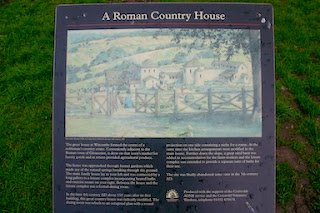This place is convenient to get to (leave the M5 at junction 11a, then off the A417), but also feels nicely secluded. It’s only reachable up a winding, dead-end farm track, the sort where you have to cross your fingers and hope you don’t meet a massive tractor half way up. The track eventually takes you to the top of a pretty combe below the scarp of the Cotswolds, and to the location of the country mansion that in The Lion and the Lamb I call ‘White Hen House’ – otherwise known as Great Witcombe Roman Villa.
 |
| Approaching the villa from the car park - the standing structures (not accessible) were built to protect the bath suite mosaics |
 Considering that Great Witcombe must once have been among the gems of late Roman villas, and considering how well it survives (relatively speaking), it’s wonderful that it’s free and accessible at any time. Presentation is minimal; there’s no visitor centre, and only a single information board offers a reconstruction of the villa in its heyday.
Considering that Great Witcombe must once have been among the gems of late Roman villas, and considering how well it survives (relatively speaking), it’s wonderful that it’s free and accessible at any time. Presentation is minimal; there’s no visitor centre, and only a single information board offers a reconstruction of the villa in its heyday.But I’m not calling Great Witcombe ‘hidden’ because it lies (literally) off the beaten track – rather, because we have yet to unearth its real secrets. The surviving foundations give a decent idea of the layout of the villa, bearing in mind that everything visible has been ‘tidied up’ since the original nineteenth-century excavations – and nineteenth-century excavations were certainly not up to the standard of modern ones. Antiquarians often dug down to get to the good stuff, i.e. solid foundations and interesting finds, without realising that simple layers of soil can tell us so much about the use and development of a site.
 |
| Original buttresses, built to stop the villa slipping down the rather steep slope |
First of all, the surveys suggest that we currently see only the uppermost parts of the villa – the two wings may actually extend almost twice as far as the currently exposed remains. What you now see could be just the upper of two full courtyards running down the slope. At the bottom of the slope, along the banks of a stream, there also seems to be a 2-acre enclosure that contained several buildings, including an earlier villa. Nearby is a possible water mill. Elsewhere there is evidence for a pottery kiln and other large-scale industrial activity, substantial terracing and landscaping, and – most intriguing of all – a possible temple-like structure on a slope overlooking the villa.
Basically, at Great Witcome we’re only seeing the cherry right now. The rest of the cake is still hidden from view, buried under turf but mercifully undisturbed by later agriculture. This was clearly one of the most important villas of late Roman Britain – a bustling community of agriculture, industry, culture and religion. Who knows what secrets lie beneath the surface in this secluded little combe, just waiting to be unearthed by the spades of future archaeologists?
No comments:
Post a Comment